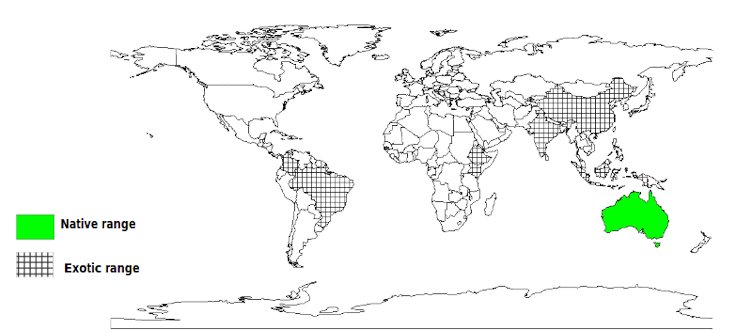Publication
from Agroforestree Database: a tree reference and selection guide
version 4.0
by C. Orwa, A. Mutua, R. Kindt, R. Jamnadass and S. Anthony
Macadamia tetraphylla Johnson
Local Names:
English (rough-shelled bush nut, Queensland nut, macadamia nut)
Family:
Proteaceae
Botanic
Description
Macadamia
tetraphylla
is a small to medium sized, densely branched tree, up to 18 m with a
diameter of 45 cm (dbh). The outer bark greyish-brown, smooth or finely
wrinkled, with numerous cream horizontal lenticels. Branchlets brown to
greyish-brown, young shoots hairy.
Leaves in whorls of 4,
simple, the margins always pricky-toothed with 33-40 teeth on each
side, oblong or oblong lanceolate, 7-25 cm long, 2-5 cm wide, abruptly
rounded to a short sharp point at the tip, rigid in texture.
Inflorescence axillary or on the branches, 10-25 cm long; flowers
creamy pink to mauve, 10 mm long.
Fruit 20-35 mm in diameter, greyish-green, turning brown.
Seed 15-30 mm long, pointed at the apex and warty.
The name tetraphyla is derived from tetra-four phylon-leaf, in allusion
to the grouping of leaves in whorls of four.
Biology
Flowers appear August - October and fruits ripen in January.
Ecology
M.
tetraphylla
is found on sub-coastal low hills and plateau, basaltic shelfs, rocky
slopes, ravines, rocky off-shore islands and headlands and in warm,
protected fertile valleys of coastal river systems. It is restricted to
eastern Australia and extends from extreme north eastern New South
Wales to overlap with M.
integrifolia
in southern Queensland. It occurs in warm sub-humid and humid zones.
The average number of frosts vary from 1-4 annually. It withstands mild
frosts but only for a short period. Rainfall is distributed through out
the year, with a summer maximum.
Associated vegetation include: Argyrodendron
trifoliatum, Dysoxylum muelleri and Castanospermun australe.
In the drier notophyll vineforest dominant genera are Ficus, Streblus and
Casine.
Biophysical
Limits
Altitude: 0-2 000 m
Mean annual temperature: 15-29 Deg C.
Mean annual rainfall: 700-2600 mm
Soil type: Soils are well-drained, fertile red loams or
alluvia derived largely from basic igneous rocks such as basalt.
Documented
Species Distribution
Native:
Australia
Exotic:
Brazil, China,
Colombia, Costa Rica, Ethiopia, Fiji, India, Indonesia, Jamaica, Kenya,
Malawi, Samoa, South Africa, Tanzania, US, Venezuela, Zimbabwe

The
map above shows countries where the species has been planted. It does
neither suggest that the species can be planted in every ecological
zone within that country, nor that the species can not be planted in
other countries than those depicted. Since some tree species are
invasive, you need to follow biosafety procedures that apply to your
planting site.
Products
Food:
Raw kernels (macadamia
nuts) are used either alone or in a wide range of confectionery and
processed foods. Macadamia oil is also produced. Hawaii dominates the
macadamia industry followed by Australia and Costa Rica. The nuts have
an excellent flavour, containing up to 76% colorless oil, suitable for
human food; the residual cake, after crushing for oil, contains 35-36 %
protein. The nut has no starch. Fancy pastries, candies and ice cream,
have been made from it. It has the advantage of retaining texture and
flavour without becoming stale when used this way.
Fuel:
Macadamia shell may be used as fuel, generating sufficient energy to
dry wet, in shell nuts.
Timber:
The wood is reddish, hard and tough, attractively marked, used in small
turnery jobs. The timber is not generally exploited.
Other products:
The decomposed husk is used in potting soils and the ground shell
supplied to the plastic industry.
Services
Shade or shelter: M. tetraphylla is
beautifully proportioned with handsome foliage, making it a fine shade
tree.
Intercropping: In
Kenya, it has been inter-cropped with coffee and food crops without
affecting the yield of these crops (ICRAF, 1992)
Tree
Management
Pruning is
necessary to remove excessive side branching as the trees are prone to
breakage and wind-throw on exposed sites. Weed control and fertilizer
application may be necessary before the canopy closes. A light crop can
be harvested in 4-5 years after planting. Where initial spacing is 14 x
4 m, yields of 6 tons/ha/year can be expected. Macadamia trees are
expected to give 40-50 years of productive life.
Germplasm
Management
Mature seed may be stored at 1-2 deg C. for several months in airtight
containers.
Budding
and grafting are the preferred techniques used. The rootstocks are
usually seedlings 9-12 months old, produced by sowing freshly
harvested, de-husked nuts of selected cultivars. The rootstocks are
soaked in tap water for 24 hours in seed boxes, containing coarse river
sand. Grafted trees come into production in 3 years.
Pests and
Diseases
There are a number of economically important pests attacking flowers,
fruits, foliage and twigs. Fungal diseases include Phytophthora cinamomi,
husk spot, blossom blight and husk rot.
Further
Reading
Allan P. 1969. Macadamia production overseas. Farming South Africa.
45(2):29-32.
Doran
CJ, Turnbull JW (eds.). 1997. Australian trees and shrubs: species for
land rehabilitation and farm planting in the tropics. ACIAR monograph
No. 24, 384 p.
Gathugu CN and Likimani EP. 1975. Macadamia nut selection programme in
Kenya. Acta Horticuturae 49: 231-236.
ICRAF. 1991. Multipurpose Trees and Shrubs database. Nairobi, Kenya.
ICRAF.
1992. A selection of useful trees and shrubs for Kenya: Notes on their
identification, propagation and management for use by farming and
pastoral communities. ICRAF.
Menniger AD. 1977. Edible nuts of the world. Horticultural Books Inc.
Wickens GE (ed.). 1995. Non-wood forest products 5; Edible nuts. FAO,
Rome
|
|
